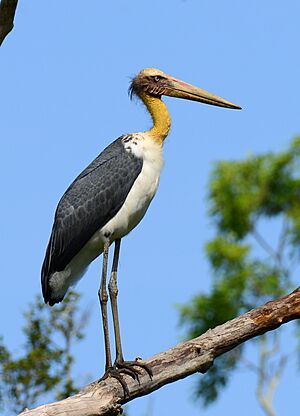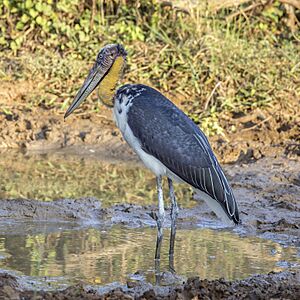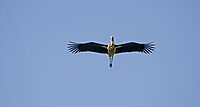Lesser adjutant facts for kids
Quick facts for kids Lesser adjutant |
|
|---|---|
 |
|
| Lesser adjutant, Yala National Park | |
| Conservation status | |
| Scientific classification | |
| Genus: |
Leptoptilos
|
| Species: |
javanicus
|
The lesser adjutant (Leptoptilos javanicus) is a very large bird that wades in water. It belongs to the stork family, called Ciconiidae. Like its relatives, it has a bare head and neck. This bird prefers to live near wetlands and usually hunts alone. It is not as likely to eat dead animals as its cousin, the greater adjutant. You can find the lesser adjutant across a wide area, from India to Southeast Asia and even to Java.
Contents
What Does the Lesser Adjutant Look Like?
This stork is quite big and stands very tall. It has a bare head and neck, meaning it doesn't have many feathers there. It also doesn't have a pouch hanging from its neck like some other storks. From its beak to its tail, it measures about 87 to 93 centimeters (34 to 37 inches) long. It weighs between 4 and 5.71 kilograms (9 to 12.6 pounds). This bird stands about 110 to 120 centimeters (43 to 47 inches) tall.
The only bird you might confuse it with is the greater adjutant. However, the lesser adjutant is usually smaller. Its upper beak is straight and measures about 25.8 to 30.8 centimeters (10.2 to 12.1 inches). The base of its beak is lighter in color. It also looks a bit thinner and less hunched over.
Its head is pale, and its upper feathers are dark, almost black. The bare head and neck have only a few scattered, hair-like feathers. The upper part of its legs is grey, not pink. Its belly and the feathers under its tail are white. Young lesser adjutants look similar to adults but are duller. They also have more feathers on their neck.
During the time they breed, the face of the lesser adjutant turns reddish. Its neck becomes orange. The larger feathers on its wings have copper spots at their tips. The inner wing feathers have thin white edges. When flying, these storks pull their necks back, just like other birds in their group. Males and females look similar, but males are usually larger and have bigger beaks.
Where Do Lesser Adjutants Live?
You can often find the lesser adjutant near large rivers and lakes. They like areas with lots of trees. They also live in freshwater wetlands, which are wet areas in farming regions. You can also spot them in coastal wetlands, like mudflats and mangrove forests.
These birds live in many countries. This includes India, Nepal, Sri Lanka, Bangladesh, Myanmar, Thailand, Vietnam, Malaysia, Laos, Singapore, Indonesia, and Cambodia. The biggest group of lesser adjutants lives in Cambodia. In India, most of them are found in the eastern states like Assam and West Bengal. They are very rare in southern India. In Sri Lanka, they live in low-lying areas, mostly inside protected parks. However, they also use wet forests and farm fields.
In Nepal, studies first thought they preferred forests with small wetlands. But later studies showed the opposite. More lesser adjutants breed successfully in farmlands in lowland Nepal.
Lesser Adjutant Behavior and Life Cycle
The lesser adjutant walks slowly through wetlands looking for food. They mainly eat fish, frogs, reptiles, and large insects. They also hunt small mammals like rodents. Sometimes, they might eat dead animals, but this is rare. They seem to find their food by looking for it. One time, storks were seen sitting on poles, watching a marsh for prey.
These birds are mostly quiet. But they do make sounds at their nests. They might clatter their beaks, hiss, or moan. When they feel threatened, they might stretch out their neck. They can also make a rough, loud sound.
When a male and female stork are becoming a pair, the female lifts her head. She makes a scooping motion and clatters her beak. This is called the "Balancing Posture." Lesser adjutants usually live alone. But during the breeding season, they gather in small groups. These groups, called colonies, never have more than 20 nests.
The breeding season changes depending on the area. In southern India, it's from February to May. In northeastern India, it's from November to January. In central Nepal, nesting can start as early as July and continue until November.
Building Nests and Raising Young
The nest of a lesser adjutant is a very large platform made of sticks. They build these nests high up in tall trees. In Nepal, many nests are built on Haldina cordifolia and Bombax ceiba trees. Some nests have been found as high as 46 meters (150 feet) in India and Myanmar. The nest can be more than a meter (3 feet) wide and deep.
Female storks lay two to four white eggs. These eggs quickly get dirty during the time they are kept warm. The eggs hatch after about 28 to 30 days.
In lowland Nepal, the average colony had about 2.9 nests. Some colonies had only one nest, while others had up to 13. The storks chose very tall and large trees for their nests. These trees were much bigger than other trees in the area. People's religious beliefs and farming methods help keep these important trees safe for the storks.
Studies in Nepal showed that larger colonies had more successful breeding. This might be because there are fewer predators in bigger groups. Also, colonies near more wetlands had better success. This helped against the negative effects of being close to people. Storks nesting in farm areas in lowland Nepal had more success than those in forests. This suggests that current farming methods, like growing rice in the wet season, are good for the lesser adjutant.
Adult storks took about 30 minutes to bring food back to their nests. This time changed depending on the size of the colony and the age of the chicks. They brought food back faster when there were more chicks. But it took longer as the chicks grew older. The breeding season in Nepal goes from the middle of the rainy season to winter. During the rainy season, there is lots of flooded rice. In winter, the land is drier and has different crops. Storks returned much faster during the rainy season. But it took longer when the crops changed and the land dried out. This shows that changes in farming can affect how well they can raise their young.
Once, a lesser adjutant paired with a painted stork at a zoo. Their baby had feathers and a beak like an adjutant. But its posture and beak shape were like a painted stork.
Conservation Efforts for the Lesser Adjutant
The lesser adjutant's conservation status has changed over time. In 2020, it was moved from "Least Concern" to "Vulnerable." This change was mostly based on studies in forests. These studies thought the species was rare and harmed by farming.
However, more detailed studies in South Asia showed these ideas were not quite right. These new studies looked closely at colonies and the areas around them. They found that the earlier ideas were likely general assumptions about farming areas. Like many other large waterbirds, lesser adjutant storks in Southeast Asia are at risk. This is due to hunting and losing their homes.
Later research showed that their population sizes are much higher than earlier guesses. The idea that this species was quickly decreasing was also found to be wrong. This is because many successful breeding colonies were found in lowland Nepal. Because of this new evidence, the conservation status of the species was changed again. It is now listed as "Near Threatened," which better shows its true situation.
Images for kids






